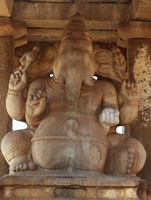 |
Statue
of Ganesha Hampi, nr Bangalore |
Son of the gods Shiva and Parvati, the elephant-headed Ganesha is known as the lord of success and the destroyer of evils and obstacles. He is remembered on the fourth (chauth or chaturthi) day of every month of the Hindu calendar, particularly on Ganesh Chaturthi, which is considered to be his birthday.
The elephant head of this deity denotes wisdom, the trunk representing Om, the divine sound considered to be the symbol of cosmic reality. In his upper right hand he holds a goad, which helps him propel humankind onto the proper path, the lasso in the upper left hand intended to capture difficulties. He is also always depicted holding a sweet, meant to signify the sweetness of a life lived in tune with the soul (atman).
A clay image of the god—in size anywhere between three-quarters of an inch to over 25 feet—will be made 2-3 months before the festival. On Ganesh Chaturthi the image will be placed on a raised platform, and the priest will chant life into it through the use of special mantras. For ten days this embodiment of Ganesha will be worshipped before it is taken through the streets to the nearest river or ocean, at which time the god will be sent off towards his abode on the holy mountain Kailash, taking with him all the misfortunes of his believers. The whole community joins in this procession shouting Ganapathi Bappa Morya, Purchya Varshi Laukariya, “O father Ganesha, come again early next year.”
In most parts of the country people will also have a ceremony (aarti) in their home shrine, offering specially blessed food (prasad) to the image of Ganesha. The entire family will dress up for the occasion, singing hymns, and showering flowers on the god. Ganesha was known for his prodigious appetite and the ceremony would not be complete without the sharing of modaks, a steamed rice dumpling that was the god’s particular favourite.